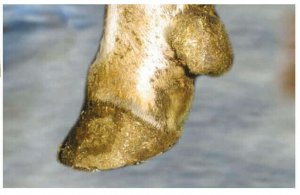Next day delivery
Order before 2:00PM
Free shipping
For orders above €100,-
Safe pay
By iDeal & Klarna
Claw diseases are a common problem on (Dutch) dairy farms. Doctoral research suggests that circa 80% of cows is suffering claw problems at any given moment through the year (Veeteelt 2010). This is visible in roughly a quarter of these animals due to lameness. On average, the costs of claw diseases are estimated at € 53 per cow present (Veeteelt 2010). Mortellaro’s disease costs dairy farms the most, followed by sole ulcers and foot rot. Claw diseases have all sorts of effects, including reduced milk production, longer time between calving, forced removal, etc. Studies show that claw diseases are number three in the list of reasons for the removal of dairy cows (Zijlstra et al. 2013). The table below lists all cost factors resulting from claw diseases (Veeteelt 2010). Plenty of reasons then for taking claw health seriously.

All claw diseases can be divided into two categories, namely infectious and non-infectious diseases. Infectious diseases are the result of problems with the skin, and not so much with the claw itself. Examples include foot rot, Mortellaro’s disease, interdigital dermatitis and tyloma. Non-infectious diseases, including sole haemorrhaging, white-line defects and sole ulcers, often originate in the feed rations, accommodation and quality of the claws themselves (GD 2018).
The main diseases are described below, supplemented with the treatment methods and preventive measures.
Mortellaro’s disease is the most common claw disease in dairy cattle. In 1974, this diseases was first described by Professor Mortellaro, who gave the disease its name. Mortellaro’s is an infection of the skin at the transition from skin to horn and is usually observable between both claws, in the so-called bulb area. A red – strawberry-like – lesion is visible with a characteristic odour. It is a painful disease for the cow. The nature of the disease is divided into five categories, namely M0 to M4, with M4 described as chronic.
 |
||
1 = light
|
2 = moderate
|
3 = severe
|
The cause of Mortellaro’s disease is an infection with Treponema bacteria. This coiled bacteria digs itself a pathway into the skin like a corkscrew and then causes inflammation in the deeper layers of skin (Lammers 2016). Treatment of this disease involves preventive treatment of the claws, regular use of foot baths and a dry living environment. It’s difficult to eliminate the disease and this rarely happens, so repeated treatment is a must. Vaccination against Mortellaro’s disease has been described in the literature, but only on a small scale and with varying success (Palmer 2015).
Foot rot in an infection of the interdigital claw skin caused by Bacteroides nodosus. It causes painful swelling and has a typical odour, hence the name foot rot. This disease is often a precursor to, or is combined with, Mortellaro’s disease (Lammers 2016).
 |
||
1 = light
|
2 = moderate
|
3 = severe
|
Good hygiene in the cowshed, with clean boxes and as little manure as possible on the gratings, helps to combat foot rot. Treatment of foot rot involves cutting away the excess horn. In combination with a good foot bath, which effectively disinfects the claw, this is sufficient to keep foot rot at bay.
Interdigital phlegmon is an inflammation of the tissue of the interdigital space.

It almost always begins with damage, for instance from stones, uneven floors, manure scrapes, etc. Damage can lead to penetration by bacteria, especially fusobacterium, and tissue damage, causing it to die off. Cows can get fever and lower appetite as a result of inflammation. Treatment aims at combating the bacteria and lowering the fever using antibiotics and/or penicillin. Depocillin is a commonly used antibiotic for this (Lammers 2016).
So-called white line disease is the link between the sole horn and the hoof wall. The structure of this is soft, which is why it’s a vulnerable area. With white line disease the claw horn is often damaged, caused by stones or other hard objects. Damage means bacteria can easily penetrate and cause inflammation.
| White line disease
|
||
1 = light
|
2 = moderate
|
3 = severe
|
Trimming the hooves thoroughly can ‘release’ the infection. After effectively disinfecting the wound, the hooves can heal. A block is often placed under the hoof to reduce the pressure on the claw (Lammers 2016).
Sole haemorrhaging is the most common – non-infectious – claw disease in dairy cows. There is visible haemorrhaging in the sole horn, resulting in severe cases in the cow becoming lame. The cause of this is often sought in feed, but the load (cow comfort) also plays an important role. When cubicles give too little comfort, cows will stand for longer, leading to extra pressure on the claws. This exacerbates sole haemorrhaging. Rumen acidification can be a major cause of this disease, as well as mycotoxins. Both can influence horn growth, resulting in sole haemorrhaging.
 |
||
1 = light
|
2 = moderate
|
3 = severe
|
Treatment of sole haemorrhaging involves cutting away the haemorrhages, supplemented where necessary with placing a block. And more important still for preventing sole haemorrhaging is to ensure that feed rations and cow comfort are as optimal as possible. Sole haemorrhaging is also sometimes referred to as a symptom with a different underlying cause. It is therefore important to reveal the underlying cause in addition to treating the haemorrhaging.
A sole ulcer is more or less the final stage of sole haemorrhaging. Sole ulcers cause a hole in the sole. This means bacteria can gain easy access to the claw and cause damage. A sole ulcer usually appears in the outer claw of the hind legs. It often goes hand in hand with foot rot. Since foot rot causes excess horn growth, the pressure distribution becomes uneven, exacerbating the sole ulcers.
 |
||
1 = light
|
2 = moderate
|
3 = severe
|
And with sole ulcers too, the cause is mainly sought in feed and cow comfort. It is also described that the (protracted) administration of biotin can have a positive effect.
In conclusion, it can be said that there are multiple claw diseases with various underlying causes and also multiple effects. Treatment focuses mainly on good hygiene and effective cow comfort. Furthermore, well-balanced feed rations are a precondition for optimal claw quality.
